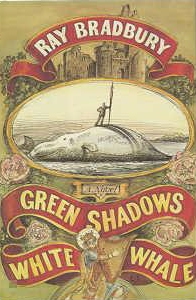One of my major literary influences is Ray Bradbury. As far as I know, I’ve been reading Bradbury’s stories since my early teens. I recall stories from English textbooks in pre-high school in Zambia, tales in Reader’s Digest editions when visiting grandparents in Norway, to my first actual books by Bradbury when I’d moved to the US in the late 1980s. At first: paperbacks picked up in used book stores, either new ones issued by Bantam Spectra, or older, tattered editions. I don’t recall when I first read Fahrenheit 451, or when I watched the movie version from my birth year. Or when I read The Martian Chronicles, or The Illustrated Man, or Dandelion Wine, or the countless other books and stories he wrote. I known that I’ve rad some of them multiple times, and that I own 29 of his books—collections or novels.
I finally met Bradbury in person in 1996, at a book signing in Austin, Texas. He signed a recently reprinted hardcover edition of Fahrenheit 451 and a first edition of Quicker Than the Eye. I could not believe my luck.
To this day, a dozen years after his death, I still look for Bradbury books that I don’t own, and try to read these books right away. This includes the mysteries, such as A Graveyard for Lunatics and Lets all Kill Constance, as well as SF stories in various collections. He’s one of my top three authors in any genre, in terms of influence and importance.
This past weekend, Half Price Books was having a 20% off sale. Who needs an additional reason to visit a book store? Anyway, I visited a pair of stores in San Antonio. In one, I found a first edition of Kazuo Ishiguro’s fourth novel, The Unconsoled. In the other, I came away with a quartet of books. Prime among these was Bradbury’s Green Shadows, White Whale. To be honest, my jaw dropped when I saw that book. Back in 1992, when it first was published, I almost bought a copy. However, at that time I still hesitated to spend more than $20 for a book, even if it was by someone like Bradbury, and when I looked again in stores a few years later, it was gone. Not even a remaindered copy remained, if ever those existed. This time, I found a copy for $8, a bargain beyond measure.

Green Shadows, White Whale is a fictionalized account of Bradbury’s journey to Ireland in the early 1950s to write a screen adaptation of Herman Melville’s novel, Moby Dick, with director John Huston. Having recently visited Dublin, it struck a chord with me to find this novel. Dublin in 2024 isn’t really Ireland; it’s Disneyland with pubs. My apologies to the Irish, but I found Dublin over-crowed and full of tourists; yes, I was one of those tourists, so maybe part of the problem. Still, I looked back to a visit to Cork a couple of decades previously and found that city more genuinely Irish. Maybe I need to spend time in the countryside. Maybe no real place no longer genuinely exists: they’re all are aimed at tourists, all full of tourists.
I look forward to reading this Bradbury novel, to laugh and cry with him as he relates his experiences and fictionalized accounts of events. There will never be his like again.